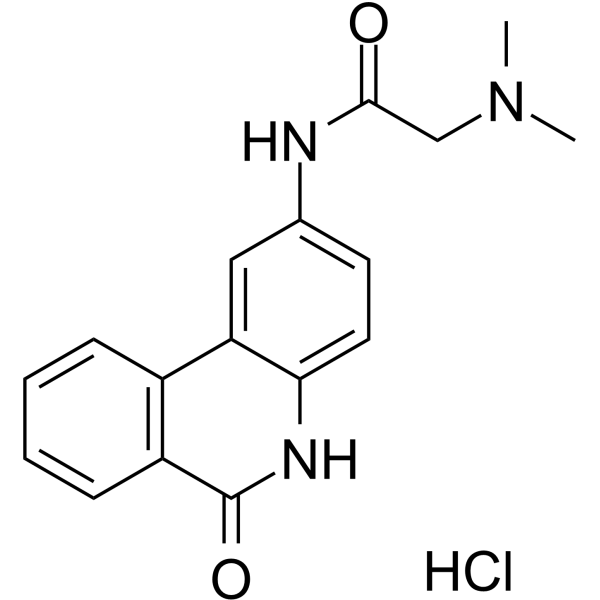上海金畔生物科技有限公司为生命科学和医药研发人员提供生物活性分子抑制剂、激动剂、特异性抑制剂、化合物库、重组蛋白,专注于信号通路和疾病研究领域。
PJ34 hydrochloride 纯度: 99.10%
PJ34 hydrochloride 是 PARP1/2 的抑制剂,IC50 值分别为 110 nM 和 86 nM。

PJ34 hydrochloride Chemical Structure
CAS No. : 344458-15-7
| 规格 | 价格 | 是否有货 | 数量 |
|---|---|---|---|
| Free Sample (0.1-0.5 mg) | Apply now | ||
| 10 mM * 1 mL in Water | ¥660 | In-stock | |
| 10 mg | ¥600 | In-stock | |
| 50 mg | ¥2000 | In-stock | |
| 100 mg | ¥3400 | In-stock | |
| 200 mg | 询价 | ||
| 500 mg | 询价 |
* Please select Quantity before adding items.
PJ34 hydrochloride 相关产品
•相关化合物库:
- Bioactive Compound Library Plus
- Cell Cycle/DNA Damage Compound Library
- Epigenetics Compound Library
- Anti-Cancer Compound Library
- Anti-Aging Compound Library
- Neuroprotective Compound Library
- Anti-Breast Cancer Compound Library
- Anti-Pancreatic Cancer Compound Library
- Targeted Diversity Library
| 生物活性 |
PJ34 hydrochloride is an inhibitor of PARP1/2 with IC50 of 110 nM and 86 nM, respectively. |
||||||||||||||||
|---|---|---|---|---|---|---|---|---|---|---|---|---|---|---|---|---|---|
| IC50 & Target[1] |
|
||||||||||||||||
| 体外研究 (In Vitro) |
PJ34 inhibits the PARP enzyme activity with an IC50 of 110±1.9 nM. To compare the neuroprotective properties of other PARP inhibitors in PC12 cells, PJ34 is evaluated using by LDH assay. PJ34 treatment also significantly and concentration dependently attenuates cell death at a concentration ranging from 10-7 to 10-5 M[1]. 上海金畔生物科技有限公司 has not independently confirmed the accuracy of these methods. They are for reference only. |
||||||||||||||||
| 体内研究 (In Vivo) |
To compare the potency and efficacy with other PARP inhibitors, PJ34 is evaluated at the doses of 3.2 and 10 mg/kg, respectively. PJ34 at the dose of 3.2 mg/kg significantly reduces cortical damage by 33%; however, 10 mg/kg dosing shows reversed effect (17% reduction)[1]. PJ34 (25 mg/kg) reduces the levels of TNF-α mRNA in ischemic animals by 70% and these values in treated mice do not differ from that of sham or naive animals. Treatment of ischemic mice with PJ34 reduces the level of E-selectin mRNA by 81% and that of ICAM-1 mRNA by 54%, compared to vehicle-treated ischemic mice[2]. 上海金畔生物科技有限公司 has not independently confirmed the accuracy of these methods. They are for reference only. |
||||||||||||||||
| 分子量 |
331.80 |
||||||||||||||||
| Formula |
C17H18ClN3O2 |
||||||||||||||||
| CAS 号 |
344458-15-7 |
||||||||||||||||
| 运输条件 |
Room temperature in continental US; may vary elsewhere. |
||||||||||||||||
| 储存方式 |
4°C, sealed storage, away from moisture *In solvent : -80°C, 6 months; -20°C, 1 month (sealed storage, away from moisture) |
||||||||||||||||
| 溶解性数据 |
In Vitro:
H2O : 50 mg/mL (150.69 mM; Need ultrasonic) DMSO : 12.5 mg/mL (37.67 mM; ultrasonic and warming and heat to 60°C) 配制储备液
*
请根据产品在不同溶剂中的溶解度选择合适的溶剂配制储备液;一旦配成溶液,请分装保存,避免反复冻融造成的产品失效。 In Vivo:
请根据您的实验动物和给药方式选择适当的溶解方案。以下溶解方案都请先按照 In Vitro 方式配制澄清的储备液,再依次添加助溶剂: ——为保证实验结果的可靠性,澄清的储备液可以根据储存条件,适当保存;体内实验的工作液,建议您现用现配,当天使用; 以下溶剂前显示的百
|
||||||||||||||||
| 参考文献 |
|
| Kinase Assay [1] |
To assess the PARP-1 or PARP-2 inhibitory activity of FR247304, 3-AB, and PJ34, PARP activity is evaluated with minor modifications. PARP enzyme assay is carried out in a final volume of 100 μL consisting of 50 mM Tris-HCl (pH 8.0), 25 mM MgCl2, 1 mM dithiothreitol, 10 μg activated salmon sperm DNA, 0.1 μCi of [adenylate-32P]NAD, 0.2 units of recombinant human PARP for PARP-1 assay or 0.1 units of recombinant mouse PARP-2 for PARP-2 assay, and various concentrations of FR261529 or 3-AB. The reaction mixture is incubated at room temperature (23°C) for 15 min, and the reaction is terminated by adding 200 μL of ice-cold 20% trichloroacetic acid (TCA) and incubated at 4°C for 10 min. The precipitate is transferred onto GF/B filter and washed three times with 10% TCA solution and 70% ethanol. After the filter is dried, the radioactivity is determined by liquid scintillation counting. 上海金畔生物科技有限公司 has not independently confirmed the accuracy of these methods. They are for reference only. |
|---|---|
| Cell Assay [1] |
PC12 cell cultured are grown in Dulbecco’s modified Eagle’s medium supplemented with 5% (v/v) fetal calf serum, 5% (v/v) horse serum, and a 1% (v/v) penicillin-streptomycin antibiotics mixture. Cells are grown in an atmosphere of 95% air and 5% CO2 at 37°C. For all experiment, cells are seeded at a density of 4×104 cells/well in 96-well culture plates and allowed to attach overnight. For assessment of cell viability, hydrogen peroxide-induced cytotoxicity is quantified by a standard measurement of LDH release with the use of the LDH assay kit. Briefly, 6 h after hydrogen peroxide exposure, 20 μL of medium of each well is collected, and the solution prepared from LDH assay kit is added. After incubation at room temperature for 30 min, the reaction is stopped by addition of 1 N HCl, and absorbance is measured at 450 nm using a microplate reader. 上海金畔生物科技有限公司 has not independently confirmed the accuracy of these methods. They are for reference only. |
| Animal Administration [1][2] |
Rats[1] 上海金畔生物科技有限公司 has not independently confirmed the accuracy of these methods. They are for reference only. |
| 参考文献 |
|
所有产品仅用作科学研究或药证申报,我们不为任何个人用途提供产品和服务
